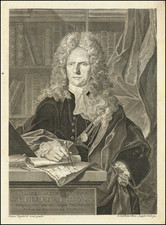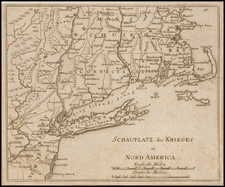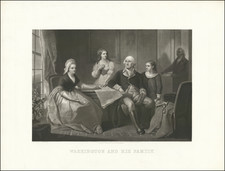Dating the Print
The inclusion of "May his name never be forgotten" has led some (Wick) to conclude that the print could be commemorative, that is, having been produced after Washington's death in 1799. More recently, Monsky has pointed out that this is unlikely to be the case, as Washington is referred to as "Commander in chief of the American Armies", a title he held from June 15, 1775 to December 23, 1783, and not as President, the title he first took in 1789.
See, Edwin Babcock Holden Sale, 927 "One of the excessively scarce original impressions reproduced in the Hart catalogue, and not to be confounded with the modern counterfeit."
See, Stan. V. Henkels, "The Unique Collection of Engraved Portraits of Gen. George Washignton...", 118 "Excessively rare. The only copy that has come under my observation."
See, Hart Catalog, 725: "The execution of this plate is very crude, and there is a recent imitation of it, more in outline than 725, with some changes in the border of saddle cloth and rosette on hat. The inscription is in letters of slightly different form, finished with pencil, and without punctuation. It is issued upon old hand-made paper with a plate mark, and is well calculated to deceive even the wary."
See Goss, The Life of Colonel Paul Revere, Volume 2, page 502:
An extensive search and correspondence fails to bring to light this portrait of Washington. W. S. Baker, of Philadelphia, who has written and published much concerning the portraits of Washington, and who has a very large collection of them, writes that he does not know of its existence. So, also, does W. F. Havemeyer, of New York, who has a large collection. William John Potts, of Camden, N. J., under date of May 14, 1891, thinks that possibly the original from which Joseph Wright engraved the portrait of Washington for the Massachu- setts Magazine, for March 1791, may have been by Revere, but there is no certain knowledge of it. No member of the Revere family now living has ever seen the original.
See, John R. Monsky, "From the Collection: Finding America in Its First Political Textile", Winterthur Portfolio , Vol. 37, No. 4 (Winter 2002), pp. 239-264:
The Kerchief and the 1783 handkerchief in turn had their own impact on additional works. One such work is an engraving shown as the frontispiece of Carl W. Drepperd’s Early American Prints, which has long puzzled print experts (fig. 5). Probably produced between 1785 and 1789, its maker and exact date are unknown. Wick dates it between 1785 and 1800, but it would appear to have been designed before 1789 because it refers to Washington as a general, not president. Wick believes that the 1783 handkerchief influenced the engraving, but it could be equally argued that the Kerchief may have had an influence on the engraving as well, as the particular language surrounding Washington and the reeling horse are derivative of the Kerchief, not the 1783 handkerchief. The legend around Washington in the engraving reads: ‘‘His Excellency GEORGE WASHINGTON Esqr. Commander in chief of the AMERICAN ARMIES. The Protector of his COUNTRY. The Supporter of LIBERTY. And the Benefactor of Mankind. May his name never be forgotten.’’5
There is one last specific result to be noted in this chain of influences. The 1785–89 engraving appears to have had, in turn, an influence on Amos Dolittle’s famous and widely reproduced work entitled ‘‘A Display of the United States of America’’ (fig. 6). Although the images in the Dolittle print and the 1785–89 engraving are completely different, the language in the legends, including the use of capitalization, are very close. The Dolittle print reads: ‘‘GEORGE WASHINGTON. President of the UNITED STATES of AMERICA. The Protector of his COUNTRY and the Supporter of the rights of MANKIND.’’6









![[ United States ] Il Canada Le Colonie Inglesi Con La Luigiana E Florida di nuova Projezione . . . 1778](https://storage.googleapis.com/raremaps/img/small/103423.jpg)
![[Charles Lindbergh] Spirit of St. Louis](https://storage.googleapis.com/raremaps/img/small/69234.jpg)



![[Daniel Friedrich Sotzmann] D. F. Sotzmann Geh. exped Secretair beym Ingen. Depart. u Geograph dur Academie der Wissenschaften zu Berlin](https://storage.googleapis.com/raremaps/img/small/69324.jpg)